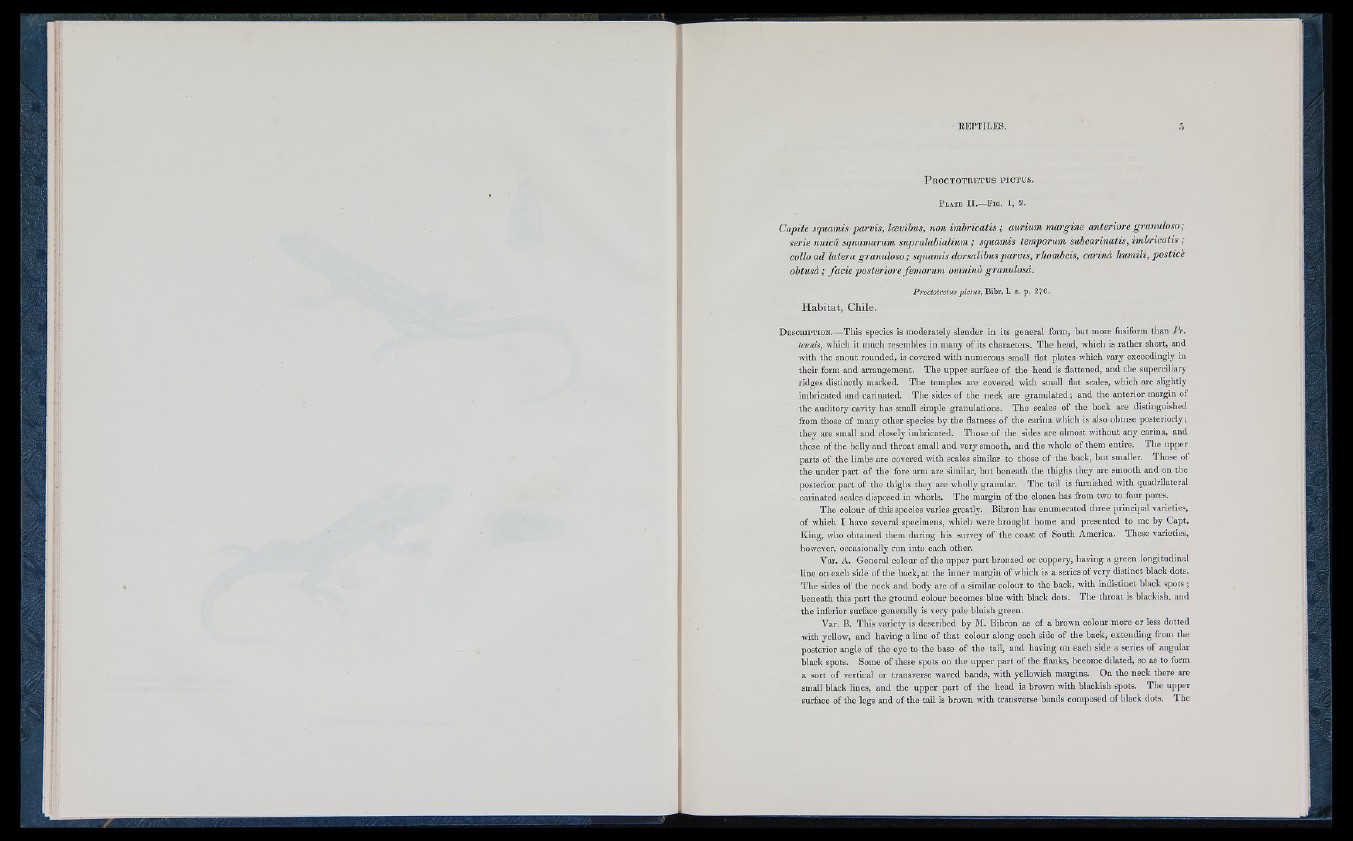
I P r o c t o t r e t u s p i c t u s .
P late I I .—F ig . 1, 2.
Capite squamis parvis, lævibus, iion hnbricatis ; aurium margine anteriore ^
serie unica squamarum supralabialium ; squamis temporum subcarinatis, imbricatis ;
collo ad latera granuloso ; squamis dorsalibus parvis, rhombeis, carinâ humili, posticè
obtusâ; fa d e posteriore femorum omninò granulosâ.
Proctotretus p ic tu s, B ib r. 1. c. p . 276.
Habitat, Chile.
D e sc r ip t io n .—T h is species is modera tely slen d er In its gene ral form, b u t more fusiform th a n Pr .
tenuis, which it much resembles in many o f its cha rac ters. T h e h ea d , which is ra th e r short, and
w ith th e sn o u t ro u n d ed , is covered with numerous small flat p lates which vary exceedingly in
th e ir form an d arran g em en t. T h e u p p e r surface o f th e h e a d is flattened, an d th e superciliary
ridges distinc tly marked. T h e temples are covered w ith small flat scales, which are slightly
imbricated an d ca rinated. T h e sides o f th e neck are g ra n u la te d ; an d th e a n te rio r m arg in o f
th e au d ito ry cavity has small simple granula tions. T h e scales o f th e back are distinguished
from those o f m an y o th e r species b y th e flatness o f th e ca rina which is also obtuse posteriorly ;
th ey are small an d closely imbricated. Those o f th e sides are almost with o u t an y c a rina, an d
those o f th e belly a n d th ro a t small an d very smooth, an d th e whole o f th em en tire . T h e u p p e r
pa rts o f th e limbs are covered with scales similar to those o f th e back, b u t smaller. Those of
th e u n d e r p a r t o f th e fore arm are similar, b u t b en e a th th e th ig h s th e y are smooth an d on th e
posterior p a r t o f th e th ig h s th ey are wholly g ranula r. T h e ta il is furnished with quadrila te ral
c a rin ated scales disposed in whorls. T h e margin o f th e cloaca has from two to four pores.
T h e colour o f th is species varies gre atly. Bibron has en um e ra ted th re e p rin cip a l varieties,
of which I have several specimens, which were b ro u g h t home an d p re sen ted to me by C ap t.
K in g , who o b tain ed th em d u rin g his survey o f th e coast o f South Americ a. These varieties,
however, occasionally ru n in to each other.
Va r. A. G e n era l colour o f th e u p p e r p a r t bro n z ed o r coppery, hav in g a g re en longitudina l
line on each side o f th e back, a t th e in n e r margin o f which is a series o f very d is tin c t black dots.
T h e sides o f th e n e c k an d body are o f a similar colour to th e back, with in d istin c t black spots ;
b en e a th this p a rt the g ro u n d colour becomes blue with black dots. T h e th ro a t is blackish, and
th e in ferio r surface g en e rally is very pale bluish g re en.
Va r. B. T h is varie ty is described by M . Bibron as o f a brown colour more o r less d otted
with yellow, a n d having a line o f th a t colour along ea ch side o f th e back, ex te n d in g from the
posterior angle o f th e eye to th e base o f th e tail, an d having on ea ch side a series o f angula r
black spots. Some o f these spots on th e u p p e r p a r t o f th e flanks, become dilated, so as to form
a sort o f vertic al o r transverse waved b ands, with yellowish margins. On th e n e c k th e re are
small black lines, an d th e u p p e r p a rt o f th e h e a d is brown w ith blackish spots. T h e u p p e r
surface o f th e legs an d o f th e ta il is brown with transverse bands composed o f black dots. T h e